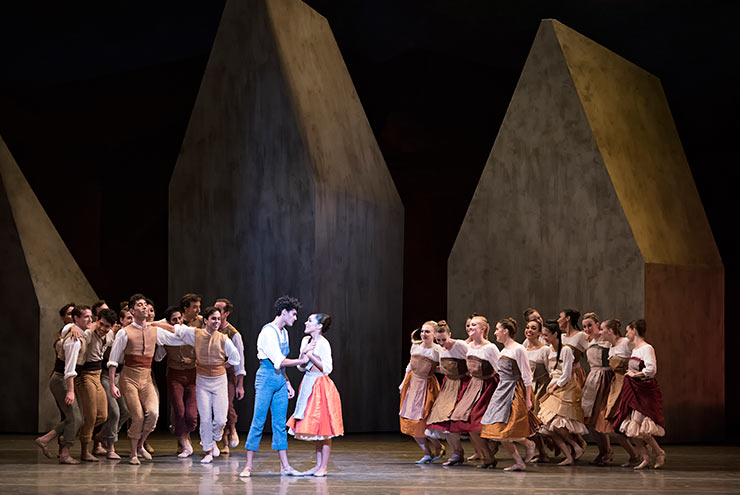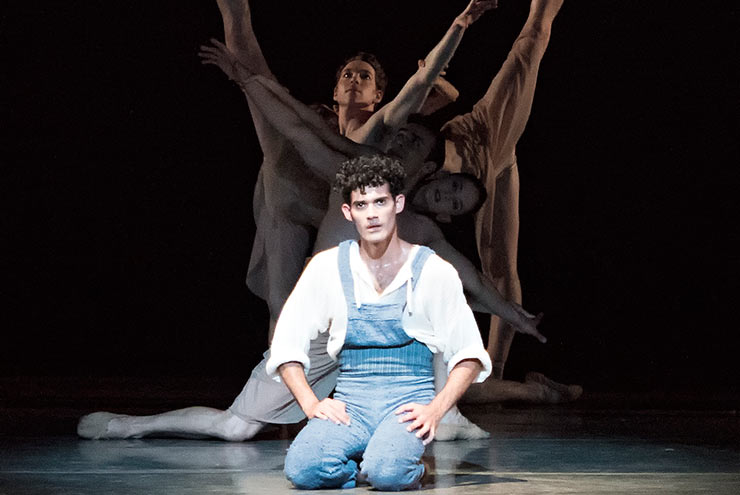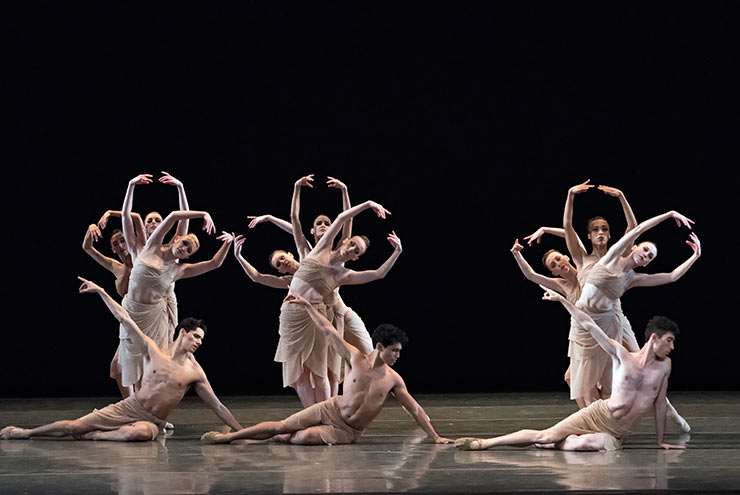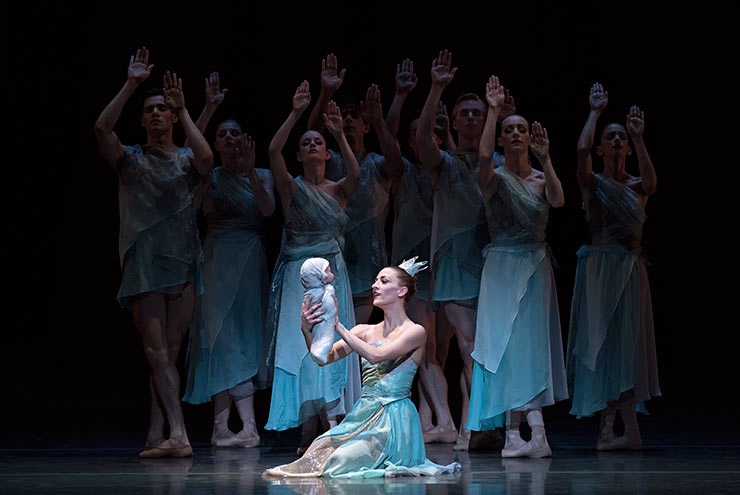
Jeanette Delgado and Renan Cerdeiro with Miami City Ballet dancers in The Fairy's Kiss. Choreography by Alexei Ratmansky. Photo © Gene Schiavone.
To dance is to sing with one’s body. Whether it be abstract, classical, a story, or the myriad of new “dance” forms of today, dancers’ “voices” continue to be challenged and audiences continue to be moved.
In Miami City Ballet’s Program Three at the Adrienne Arsht Ziff Opera House, audiences saw three diverse ballets that exemplified this range; one company premiere in George Balanchine’s sparkly “Walpurgisnacht Ballet,” one revival in Christopher Wheeldon’s abstract “Polyphonia,” and one highly anticipated world premiere in “The Fairy’s Kiss” by Alexei Ratmanski. The entire evening offered an array of styles and genres, something for everyone.

Renan Cerdeiro and Miami City Ballet dancers in The Fairy's Kiss. Choreography by Alexei Ratmansky. Photo © Gene Schiavone.
It is difficult to tell a story through dance and do it well. Among many, noted “story tellers” are Sir Frederick Ashton and Sir Kenneth MacMillan from England’s Royal Ballet, John Cranko from The Stuttgart Ballet, and the more recent Yuri Possokhov, choreographer in residence at San Francisco Ballet. Their works are enduring and performed by companies throughout the world.

Miami City Ballet dancers in The Fairy's Kiss. Choreography by Alexei Ratmansky. Photo © Gene Schiavone.
St. Petersburg born and Bolshoi Ballet School trained, Alexei Ratmanski, the choreographer of “The Fairy’s Kiss,” has undoubtedly joined these ranks. Artist in residence of New York’s American Ballet Theater, Ratmanski has cut his teeth on recreating classical story ballets for today’s public.
A detailed researcher and historian, his vision to tell a story is clear, uncluttered and rich. In “The Fairy’s Kiss,” while it is loaded with undertones, the simple clarity of vocabulary and identifiable characters make this an enjoyable ballet.
Add to that the surreal starkness and seamless transitions of the collaborative efforts of Jérôrme Kaplan (set), Wendall K. Harrington (projection), and James F. Ingalls (lighting) and a magical tale of art and beauty unfolds.
Artistic Director Lourdes Lopez told the story of “The Fairy’s Kiss” in her thoughtful pre-performance comments. Inspired by the Hans Christian Anderson story of “The Ice Maiden,” the Ratmanski version is a simple allegory that ultimately is about being kissed by a passion and living life to fulfill the needs of that passion.
In this tale, that passion is dance. While the story was clear, it was the momentary odes to various ballets that made the telling of it so brilliant. Winter fairies could have been from Ashton’s “The Dream.”
The beautifully cool and elegant Simone Messmer as the lead fairy (flawlessly cast) was carried in reminding one of the Siren in “Prodigal Son.” Even the moment that the baby was randomly tossed (which in itself seemed rather horrific) must have been a tribute to Ashton’s “La Fille Mal Gardée.” This ballet was about dance infusing the senses.

Simone Messmer and Miami City Ballet dancers in The Fairy's Kiss. Choreography by Alexei Ratmansky. Photo © Gene Schiavone.
Renan Cerdeiro was our young man who was kissed by the fairy to join the otherworld of dance. The dynamic Cerdeiro was looking stronger than ever, morphing from the capricious young lover to the distraught groom taken from his bride, evolving to a man ensconced in the world of dance and art. The very human Jeanette Delgado, his young bride to be, was rosy cheeked with anticipation and spritely in her every step.
Ratmanski did not try to be clever, but the entirety was, oh, so clever. There was sweetness to the bride and groom in their youthful encounters. The ensemble danced, the lovers flirted, the friends tittered and gypsies were gypsies. Cerdeiro’s pas with the disguised Fairy, Messmer, carried maturity and darkness until their final kiss sealed a transformative future. The final series of tableaux was a look into Cerdeiro’s soul.
Without moving, he was ensconced by images from a plethora of ballets, that blended and filtered one to the other. It would take a few viewings to realize the extent, but the lovely transitioning cascades from Massine’s “Les Presages” were prevalent with references to “Les Noces,” “Apollo,” “La Bayadere,” “Serenade,” and on.
The picturesque final tableaux from “Les Presages” said it all. Art has, and always will, overcome, just as the hero has overcome the strife of war. This enjoyable ballet needs to be viewed a few times. The remainder of the program included Balanchine’s detailed and vivacious, “Walpurgisnacht Ballet” led by the facile and creature-esque Nathalia Arja and the joyous Lauren Fadeley partnered by steadfast Jovani Furlan. No one moves dancers around the stage like Balanchine and this is a perfect textbook example. Flying hair, arms, energetic feet and virtuoso, but simple technique. The company was precise and dazzling.
Christopher Wheeldon’s “Polyphonia" is done by companies the world over. Abstract technique, a choreographic craft that is undeniable, and a variety of duets and solos in many moods make this ballet a treasure for dancers. The ten piano episodes, played by Francisco Rennó, provide inspiration and impetus for each mood.
A highly polished cast exemplified the idea that dancers are also athletes and artists. Emily Bromberg and Renato Penteado were lovely in a simple series of promenades, Jovani Furlan and Kleber Rebello astounded in their duet, the speedy Jennifer Lauren and Rebello took your breath away, and Tricia Albertson and Reyneris Reyes were mesmerizing in their abstract, yet classical duet. “Polyphonia” takes classical ballet to a new level as is demonstrated in the final horizontal lift.
The Opus One Orchestra conducted by Gary Sheldon provided the gorgeous range of music, from Gounod and Ligetti to Stravinsky. This was a welcome and just partnering for the entire evening.
Miami City Ballet performs Friday, Feb. 24 and Saturday, Feb. 25 at 8 p.m. Saturday, Feb 25 at 2 p.m. and Sunday, Feb. 26 at 1 p.m. at the Kravis Center, 701 Okeechobee Blvd, West Palm Beach, FL 33401 (561) 832-7469.
Performances continue Saturday, March 11 at 8 p.m. and Sunday, March 12 at 2 p.m. at the Broward Center Au Rene Theater, 201 SW 5th Ave., Fort Lauderdale, FL 33312 (954) 462-0222
MCB Box office: (305) 929-7010, boxoffice@miamicityballet.org or miamicityballet.org
 MAIN MENU
MAIN MENU

